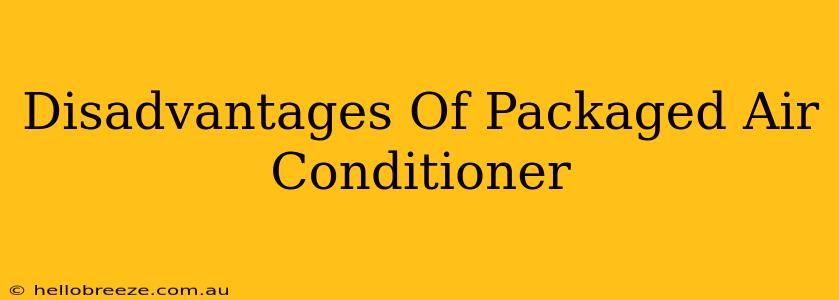Packaged air conditioners, while offering a convenient all-in-one cooling solution, aren't without their drawbacks. Understanding these disadvantages can help you make an informed decision about whether this type of system is right for your needs. This article explores the key downsides of packaged air conditioners to help you weigh your options.
High Initial Cost
One of the most significant disadvantages is the high upfront cost. Packaged units are generally more expensive to purchase and install than other air conditioning systems like split systems or window units. This is due to their larger size, more complex components, and the specialized installation required. The expense can be a major deterrent for many homeowners on a budget.
Impact on Budget
This higher initial investment can significantly impact your budget, potentially delaying other home improvement projects or creating financial strain. Careful consideration of your financial resources is crucial before committing to a packaged air conditioner.
Limited Flexibility and Placement
Unlike split systems that allow for more flexible placement of indoor and outdoor units, packaged units are typically installed as a single, larger unit. This limits placement options and may not be suitable for all homes or building designs. You might find yourself constrained by available space and the unit's overall dimensions.
Architectural Considerations
Before purchasing, carefully consider the architectural aspects of your home. Will the unit fit through doorways, windows, and hallways? Is there adequate space for proper ventilation and servicing? These factors are crucial for a successful installation.
Higher Energy Consumption
While energy efficiency has improved in recent years, packaged units generally consume more energy than comparable split systems. This can lead to higher electricity bills, particularly during periods of peak usage. The larger size and less efficient design contribute to this increased energy consumption.
Long-Term Energy Costs
It's vital to factor in the long-term energy costs associated with running a packaged air conditioner. Look for units with high SEER (Seasonal Energy Efficiency Ratio) ratings to mitigate these expenses. An energy audit can help you determine the potential impact on your energy bills.
Noise Levels
Packaged air conditioners can be noisier than other cooling systems. The entire unit, including the compressor, fan, and condenser, is housed in a single cabinet, which can amplify the sound. This can be disruptive, especially if the unit is located close to living areas or bedrooms.
Noise Pollution Concerns
Consider the proximity of the unit to windows, bedrooms, and other noise-sensitive areas. Research the decibel rating of different models to minimize potential noise pollution.
Maintenance and Repairs
While generally durable, packaged air conditioners can require more extensive maintenance and repairs due to their complexity. Finding qualified technicians to service these larger units might also prove challenging in some areas. This increases the likelihood of costly repairs and downtime.
Costly Servicing
Factor in the potential for higher maintenance and repair costs when budgeting for a packaged air conditioner. Regular preventative maintenance can help minimize these expenses.
Conclusion
Packaged air conditioners provide convenient, all-in-one cooling, but they come with trade-offs. The high initial cost, limited placement flexibility, higher energy consumption, noise levels, and potential for expensive maintenance and repairs are significant factors to weigh carefully before making a purchase. Thorough research and a realistic assessment of your needs and budget are essential for making an informed decision. Consider consulting with HVAC professionals to explore alternative options that may better suit your specific requirements.

